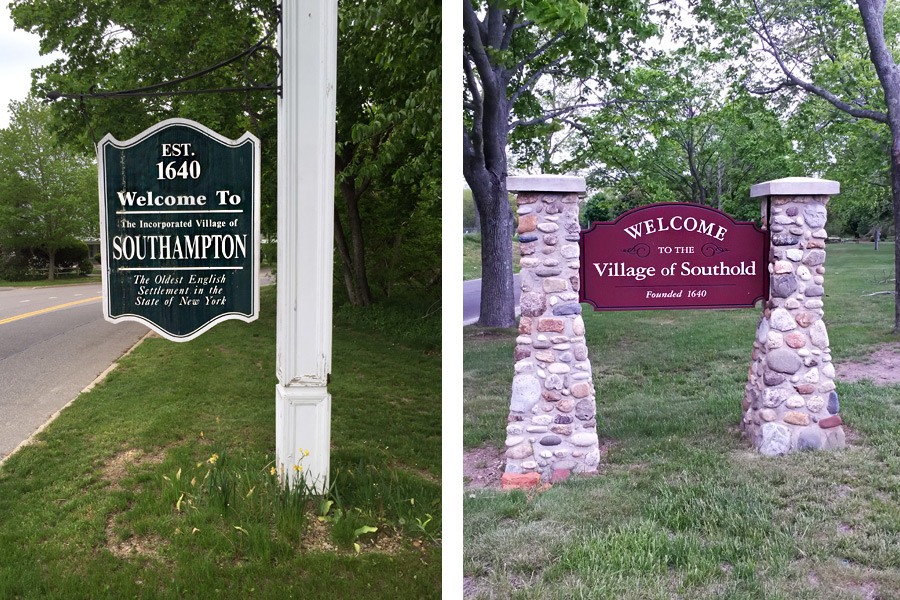Southampton vs. Southold: Which Town Is Older at 375?

If you drive along Route 25 to where you enter Southold, you will see a sign reading “Welcome to the Village of Southold, Founded 1640.”
But if you drive along Route 27A to where you enter Southampton, you will see a sign reading “Established 1640. Welcome to the Incorporated Village of Southampton. The Oldest English Settlement in the State of New York.”
Obviously, one of these places is First. And the other is Second. But just as obviously, both of these communities are too stubborn to give up on claiming this title.
One might think that what happened in 1640 stays in 1640. But that is not the case. As it happens, one can easily delve deeply into this great divide and find the facts to try to sort out who is Number 1 and who is Number 2. But as the historians of each of these communities, separated as they are by 40 miles of driving, say, it depends how you look at it.
Well, let’s look at it.
Both groups of settlers came from New England. But they were from very different parts of New England, and one had no idea that the other was coming across Long Island Sound to settle at the same time.
Those who would settle in Southold were church-going Puritans from New Haven, Connecticut, just a short distance across Long Island Sound. You can see the shore from one to the other, as you know. The settlers, a religious people, knew farming (potatoes, parsnips, carrots) and keeping sheep, goats and cattle. There had been, before 1640, an advance party of strong men who had purchased a long stretch of this land from the Corchaug Indians, cleared a small part of it, and returned to tell their leader, Reverend John Youngs, that the land was ready for them. Rev. Youngs then organized their church anew and led his flock of about two dozen men and women across Long Island Sound in a sailing ship to where one man—carpenter and adventurer Richard Jackson of Massachusetts—had built a house. They called this land Yennecott. The settlement was laid out in four acre lots.
The stretch of wooded land the advance men had bought, by the way, was quite substantial. It stretched from what is today Wading River to Orient Point. About 40 miles. They did not think small in those days.
The first thing that Rev. Youngs ordered built upon their arrival was a church. It was built on the northeast corner of the present-day cemetery of the First Church of Southold and it became not only the holy centerpiece of the town, but also the seat of government and the arsenal. Laws were passed. Each citizen had to stand watch over the community on a regular schedule. Each citizen had to have a gun and ammunition. There was a gun rack at the church where the parishioners could park guns during services.
The community also hired a famous Indian fighter, John Underhill, and gave him a house to live in at the center of the community on Feather Hill, but his services were never needed.
This was a strict, frugal, prudent and law-abiding community of farmers. They vested the authority of enforcing their laws in the church. They followed what they called the Mosaic Code, which was the Ten Commandments. Outsiders were specifically excluded. Only free white men could be part of the Town government. And no criticism was brooked. There is an account in Town records in 1687 of one Humphrey Norton, a Quaker, who was convicted of criticizing Reverend Youngs and was, as punishment, whipped and branded with the letter “H” on the back of his hand. “H” stood for heretic. He was then banished from Southold.
If the settling of Southold was sober, disciplined and organized, the settling of Southampton was the exact opposite. A sloppy sort of international politics played itself out in the settling of Southampton.
Prior to 1640, the English occupied New England, under the auspices of King Charles I. Meanwhile, a settlement on the island of Manhattan had been created under the auspices of the Dutch. The two places were organized very differently. New England was a land of law and order and democratic procedures. Nieuw Amsterdam, as the Dutch settlement was called, was settled as a business. The centerpiece of was a fort, which defended the interests of the Dutch West India Company, and the purpose of it was to be a trading post for fur trappers, for the Indians and, incidentally, with the English.
When the Dutch began expanding outward on Long Island to the east to such places as Flushing, Hempstead and Brooklyn, the English decided to encourage the English settlers in New England to establish a colony on the eastern end of Long Island to block the advance.
In 1636 the King requested that the Plymouth Colony (also called the Corporation for New England) issue a patent to the Earl of Stirling for Long Island. In 1636, the Earl gave power of attorney to James Farrett to “dispose” of the lands. England and Holland were now on a collision course, and many think James Farrett was instructed to create his English colony as close to the most easterly Dutch colony as he could without creating an international incident, thus stopping the Dutch in their tracks.
The people who actually did the settling, a small group of English Puritans, set sail from Lynn, Massachusetts, north of Boston. Most were from Lynn, and others were new arrivals from England who, it is believed, found themselves short of land to set up farms in Lynn. Some of the men going on this ship contributed between five and fifty pounds and so got a proportion of the interest of the vessel, and, later, the settlement.
This ship left Lynn, full of people and provisions, sometime in early March 1640. They sailed a few days, and did not land at Southampton. They landed about 80 miles to the west, at Manhasset, in Cow Bay (or Schout’s Bay as the Dutch called it). And there they learned, by seeing a wooden sign on a tree that they were too late. Just a few days earlier, the local Indians had signed over the ownership of this land to the Dutch. The sign on the tree was a coat of arms of the Prince of Orange. Lieutenant Howe, the leader of this expedition, pulled this sign down. Another member of the expedition then drew a scowling face on another piece of wood and they put that up.
Things went very badly for the English after that. The local Indian Sachem, Penhawitz, ran to the Dutch nearby to tell them some “foreign strollers” had arrived at Shout’s Bay and were cutting down trees and starting to build houses. The Dutch, with guns, led by Commissary Van Curler, went to see and as a result later recorded that indeed “the arms of the state” had been torn down, and that in its place was “an unhandsome face, all which aforesaid appeared strange to us, being a criminal offense against his Majesty and, tending to the disparagement of their High Mightinesses.”
A group of 20 armed Dutchmen then arrived, led by Cornelis Van Tienhoven, and he ordered all of the English, except for one woman and two children, arrested, and brought to jail to await a hearing.
Here is the account of Cornelis Van Tienhoven.
“(We) arrived at the clearing on May 15th, finding one small house built and another unfinished. They were asked what they were doing there; by what power or by whose authority they presumed to settle on our purchased soil, and told that they must show their commission. Eight men, one woman and a little child made answer that they intended to plant there and were authorized thereunto by a Scotchman who had gone with their commission to Red Hill. Secondly they were asked for what reason did they throw down their High Mightinesses Arms and set up a fool’s face in its stead. To which some answered, the escutcheon was cut down by a person who is not present; another answered, such was done in their presence by order of a Scotchman, James Farrett; and he and Lieutenant Howe were then at Red Hill.”
There was a trial two days later in Fort Amsterdam, and the upshot was they were found not guilty of tearing down the arms of the Lords and set at liberty on the condition they depart for their own territory and not come back without the Director’s express consent.
After this, the English left and there is no more paper trail to tell us what happened until December 1640, when an official document signed by the Indians stating that they are hereby selling what was now called Southampton to the English. But in this letter, there is a reference to the fact that the Indians had made AN EARLIER verbal agreement in late May 1640 to sell Southampton to the English and that agreement was hereby confirmed.
So we know something happened between May 1640 and December 1640 regarding the settlement at Southampton. But we don’t know what or exactly when.
Southold historians point out that no Southampton historian ever disputed that Southold came first until about 1820, when an article in a newspaper declared that Southampton thought they were first.
Southampton historians point out that on that day in late May, the early settlers from Lynn got evicted from Manhasset, but their goal was to form a settlement on Long Island to challenge the Dutch somewhere. Here they were at Manhasset, with a boatload of settlers, supplies and equipment, and they had settled too far west and met the Dutch. Would they have gone back to Lynn? Not likely. They were loaded up for a landing and would have sailed east looking for somewhere else.
We know that, upon landing at Southampton, a woman allegedly shouted as she came ashore “for conscience sake, we are on dry land once more,” and if nobody knows exactly what it means, it surely is a cry of happiness that, finally, they had gotten somewhere.
Earlier, scouts had come ashore to look around. They met some friendly Shinnecock Indians. It’s only a day’s sail from Manhasset to Southampton so it must have been still in late May or early June. And the Southold landing did not happen until November.
So Southampton is first? Maybe.
What we also know is that upon their landing in Southampton, the Indians led the settlers southward from their landing place (at the spot marked with a monument as “Conscience Point”) to a more wooded area about 3 miles to the south near where Southampton Hospital is today. This is where, with the help of the Indians, they dug foundations to live through the winter in partially underground huts after which they would erect buildings with wood they cut down. They did build a church, but they also built a “meeting house.” And they went about their lives. Later, when the population grew, a new downtown was created less than a mile west of the original downtown of Southampton, And the first one today, by the hospital, is called “Old Town” and the second one is today called, unceremoniously, “Southampton.”
And you know the rest.
Soon after the awkward encounter between the Dutch and the English at Manhasset, a group of four arbitrators decided there should be an invisible line from the most westernmost part of Oyster Bay going south to the Atlantic Ocean. West of that line would be Dutch land, and east would be English land. This was in 1650. Fourteen years later, in 1664, the English sent a series of gunboats and Men-O-War down the Hudson River to demand that the Dutch surrender Nieuw Amsterdam. Peter Stuyvesant, the Dutch Director-General of Nieuw Amsterdam, knew that his men, the police, the security people and the employees of the Dutch East India Company would be no match for the English Navy, and so flew the white flag to avoid bloodshed fighting a war he could not win. And all the rest is history.
Which town is first? Can’t say. Depends how you look at it.









